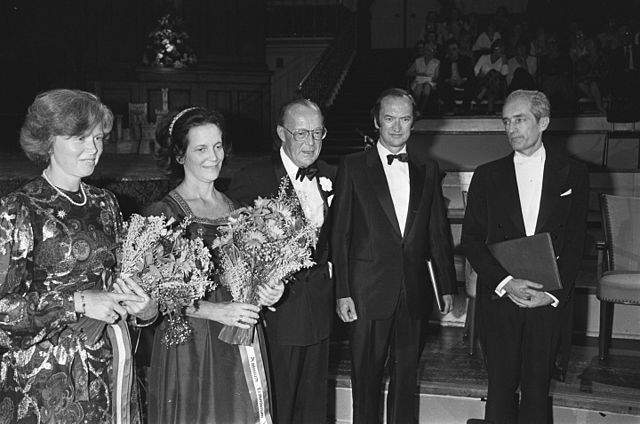
The early music world lost one of its most important figures when Nikolaus Harnoncourt passed away on March 5th, 2016. His long career ranged from Bach to Beethoven, and from Monteverdi to Gershwin. In addition to his early career as a modern cellist, he was one of the most influential early music pioneers of the 20th century, and greatly respected for his work as a mainstream maestro. This hour on Harmonia, we’re looking back at the life and career of this great man.
We heard the final three movements of a suite by Marin Marais for flute, viola da gamba, and harpsichord, featuring Nikolaus Harnoncourt on the gamba.
"I Hate Specialists"
“I hate specialists,” Nikolaus Harnoncourt told an interviewer back in 1996, at an interview conducted at his home in the Austrian Alps, near Salzburg. The cellist, renowned early-music expert, and multi-faceted conductor, was, at the time of the interview, nearing seventy, famous all over the world for his diverse career. That career included a great deal of work with Concentus Musicus Wien, the period-instrument ensemble he had cofounded with his wife, Alice Harnoncourt, a violinist, back in 1953. One of the ensemble’s most ambitious projects included recording a complete cycle of J. S. Bach’s surviving cantatas – nearly two hundred of them! The set, which Harnoncourt co-directed, in conjunction with his friend, the Dutch harpsichordist Gustav Leonhardt, was recorded in the 1970s and ‘80s and was originally released on the Teldec label. It was a monumental achievement. We heard the first half of J. S. Bach’s sacred cantata, “Wie schön leuchtet der Morgenstern,” performed by some of the best-known pioneers of the early music movement, all under the direction of Nikolaus Harnoncourt.
BWV 1, Part 2
While Nikolaus Harnoncourt’s musical interests varied widely, from Monteverdi to Beethoven to Gershwin, the music of J. S. Bach proved to be an abiding passion. Bach’s sacred cantata, “Wie schön leuchtet der Morgenstern,” or, “How brightly shines the morning star,” BWV 1, was composed in 1725 in Leipzig, for the feast of the Annunciation. In Harnoncourt’s recording, made some 250 years later, the musicians strove to present the music just as Bach himself might have heard it, back in 1725. We heard the second half of J. S. Bach’s sacred cantata, “Wie schön leuchtet der Morgenstern,” performed by some of the best-known pioneers of the early music movement, all under the direction of Nikolaus Harnoncourt.
Music of Marin Marais
Today on Harmonia, we’re celebrating the life and work of early music pioneer Nikolaus Harnoncourt, who passed away at 86, on March 5th, 2016, just three months after announcing his retirement from the ensemble he had founded. Harnoncourt, who was also extraordinarily well known for his work as a conductor of mainstream orchestras, was born on December 6th, 1929, in Berlin, to an aristocratic family. He was raised in Graz, Austria, where he served, under duress, in the Hitler Youth. “If you didn’t go there every Wednesday and Saturday,” he said, “the Hitler Youth police would come, fetch you, cut your hair and toss you into a group with other difficult ones who were treated terribly.” He played cello in the Vienna Symphony Orchestra from 1952 until 1969, where he met his wife, Alice. At the time of his departure from the orchestra, he also performed regularly on the viola da gamba, frequently accompanying his wife, a baroque violinist. We heard Marin Marais’s “Sonnerie de Sainte-Geneviève,” performed by Alice Harnoncourt on baroque violin, Nikolaus Harnoncourt on viola da gamba, and Herbert Tachezi on the harpsichord.
Harnoncourt's Final Recording
Nikolaus Harnoncourt remained active as a conductor almost up until the time of his death. On December 5th, 2015, he announced his retirement, one day prior to his 86th birthday. “My bodily strength requires me to cancel my future plans,” he wrote in a handwritten letter, which was inserted into the program that the Concentus Musicus Wien performed on his birthday, the very next day. One of his last recordings with the ensemble was of Beethoven’s Fourth and Fifth Symphonies. That recording, released soon after Harnoncourt’s death in March 2016, shows a masterful artist at the height of his powers. We heard the final movement of Beethoven’s Fifth Symphony, performed by the Concentus Musicus Wien, under the direction of their founder, Nikolaus Harnoncourt.
Break and theme music
:30, Muffatt – Biber: Suites & Sonatas, Concentus Musicus Wien, DG 2007, Tr. 19 Sonata in D Minor, II. Poco allegro (excerpt of :45
:60, Muffatt – Biber: Suites & Sonatas, Concentus Musicus Wien, DG 2007, Tr. 26 Sonata in D Minor, IX. Allegro (excerpt of 1:20)
:30, Muffatt – Biber: Suites & Sonatas, Concentus Musicus Wien, DG 2007, Tr. 37 Lamento der Verwundten Musquetirer (excerpt of 1:17)
Theme: Danse Royale, Ensemble Alcatraz, Elektra Nonesuch 79240-2 1992 B000005J0B, Tr. 12 La Prime Estampie Royal
The writer for this edition of Harmonia is Elizabeth Clark.
Learn more about recent early music CDs on the Harmonia Early Music Podcast. You can subscribe on iTunes or at harmonia early music dot org.









